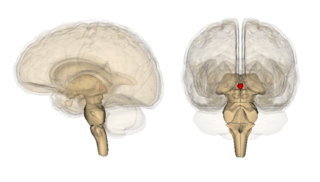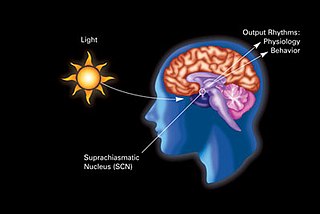Free-running sleep is a rare sleep pattern whereby the sleep schedule of a person shifts later every day. It occurs as the sleep disorder non-24-hour sleep–wake disorder or artificially as part of experiments used in the study of circadian and other rhythms in biology. Study subjects are shielded from all time cues, often by a constant light protocol, by a constant dark protocol or by the use of light/dark conditions to which the organism cannot entrain such as the ultrashort protocol of one hour dark and two hours light. Also, limited amounts of food may be made available at short intervals so as to avoid entrainment to mealtimes. Subjects are thus forced to live by their internal circadian "clocks".

A circadian rhythm, or circadian cycle, is a natural oscillation that repeats roughly every 24 hours. Circadian rhythms can refer to any process that originates within an organism and responds to the environment. Circadian rhythms are regulated by a circadian clock whose primary function is to rhythmically co-ordinate biological processes so they occur at the correct time to maximise the fitness of an individual. Circadian rhythms have been widely observed in animals, plants, fungi and cyanobacteria and there is evidence that they evolved independently in each of these kingdoms of life.

The pineal gland is a small endocrine gland in the brain of most vertebrates. The pineal gland produces melatonin, a serotonin-derived hormone which modulates sleep patterns in both circadian and seasonal cycles. The shape of the gland resembles a pine cone, which gives it its name. The pineal gland is located in the epithalamus, near the center of the brain, between the two hemispheres, tucked in a groove where the two halves of the thalamus join. It is one of the neuroendocrine secretory circumventricular organs in which capillaries are mostly permeable to solutes in the blood.

Melatonin is a natural compound, specifically an indoleamine, produced by and found in different organisms including bacteria and eukaryotes. It was discovered by Aaron B. Lerner and colleagues in 1958 as a substance of the pineal gland from cow that could induce skin lightening in common frogs. It was subsequently discovered as a hormone released in the brain at night which controls the sleep–wake cycle in vertebrates.

The suprachiasmatic nucleus or nuclei (SCN) is a small region of the brain in the hypothalamus, situated directly above the optic chiasm. The SCN is the principal circadian pacemaker in mammals, responsible for generating circadian rhythms. Reception of light inputs from photosensitive retinal ganglion cells allow the SCN to coordinate the subordinate cellular clocks of the body and entrain to the environment. The neuronal and hormonal activities it generates regulate many different body functions in an approximately 24-hour cycle.

Pinealocytes are the main cells contained in the pineal gland, located behind the third ventricle and between the two hemispheres of the brain. The primary function of the pinealocytes is the secretion of the hormone melatonin, important in the regulation of circadian rhythms. In humans, the suprachiasmatic nucleus of the hypothalamus communicates the message of darkness to the pinealocytes, and as a result, controls the day and night cycle. It has been suggested that pinealocytes are derived from photoreceptor cells. Research has also shown the decline in the number of pinealocytes by way of apoptosis as the age of the organism increases. There are two different types of pinealocytes, type I and type II, which have been classified based on certain properties including shape, presence or absence of infolding of the nuclear envelope, and composition of the cytoplasm.
Non-24-hour sleep–wake disorder is one of several chronic circadian rhythm sleep disorders (CRSDs). It is defined as a "chronic steady pattern comprising [...] daily delays in sleep onset and wake times in an individual living in a society". Symptoms result when the non-entrained (free-running) endogenous circadian rhythm drifts out of alignment with the light–dark cycle in nature. Although this sleep disorder is more common in blind people, affecting up to 70% of the totally blind, it can also affect sighted people. Non-24 may also be comorbid with bipolar disorder, depression, and traumatic brain injury. The American Academy of Sleep Medicine (AASM) has provided CRSD guidelines since 2007 with the latest update released in 2015.

The epithalamus is a posterior (dorsal) segment of the diencephalon. The epithalamus includes the habenular nuclei, the stria medullaris, the anterior and posterior paraventricular nuclei, the posterior commissure, and the pineal gland.
Circadian rhythm sleep disorders (CRSD), also known as circadian rhythm sleep-wake disorders (CRSWD), are a family of sleep disorders which affect the timing of sleep. CRSDs arise from a persistent pattern of sleep/wake disturbances that can be caused either by dysfunction in one's biological clock system, or by misalignment between one's endogenous oscillator and externally imposed cues. As a result of this mismatch, those affected by circadian rhythm sleep disorders have a tendency to fall asleep at unconventional time points in the day. These occurrences often lead to recurring instances of disturbed rest, where individuals affected by the disorder are unable to go to sleep and awaken at "normal" times for work, school, and other social obligations. Delayed sleep phase disorder, advanced sleep phase disorder, non-24-hour sleep–wake disorder and irregular sleep–wake rhythm disorder represents the four main types of CRSD.

The dorsomedial hypothalamic nucleus is a nucleus of the hypothalamus. It is involved in feeding, drinking, body-weight regulation and circadian activity. More specifically, it is a necessary component for the expression of numerous behavioral and physiological circadian rhythms. The dorsomedial hypothalamic nucleus receives information from neurons and humors involved in feeding regulation, body weight and energy consumption, and then passes this information on to brain regions involved in sleep and wakefulness regulation, body temperature and corticosteroid secretion.
Melatonin receptors are G protein-coupled receptors (GPCR) which bind melatonin. Three types of melatonin receptors have been cloned. The MT1 (or Mel1A or MTNR1A) and MT2 (or Mel1B or MTNR1B) receptor subtypes are present in humans and other mammals, while an additional melatonin receptor subtype MT3 (or Mel1C or MTNR1C) has been identified in amphibia and birds. The receptors are crucial in the signal cascade of melatonin. In the field of chronobiology, melatonin has been found to be a key player in the synchrony of biological clocks. Melatonin secretion by the pineal gland has circadian rhythmicity regulated by the suprachiasmatic nucleus (SCN) found in the brain. The SCN functions as the timing regulator for melatonin; melatonin then follows a feedback loop to decrease SCN neuronal firing. The receptors MT1 and MT2 control this process. Melatonin receptors are found throughout the body in places such as the brain, the retina of the eye, the cardiovascular system, the liver and gallbladder, the colon, the skin, the kidneys, and many others. In 2019, X-ray crystal and cryo-EM structures of MT1 and MT2 were reported.

In neuroanatomy, the retinohypothalamic tract (RHT) is a photic neural input pathway involved in the circadian rhythms of mammals. The origin of the retinohypothalamic tract is the intrinsically photosensitive retinal ganglion cells (ipRGC), which contain the photopigment melanopsin. The axons of the ipRGCs belonging to the retinohypothalamic tract project directly, monosynaptically, to the suprachiasmatic nuclei (SCN) via the optic nerve and the optic chiasm. The suprachiasmatic nuclei receive and interpret information on environmental light, dark and day length, important in the entrainment of the "body clock". They can coordinate peripheral "clocks" and direct the pineal gland to secrete the hormone melatonin.

Melatonin receptor type 1A is a protein that in humans is encoded by the MTNR1A gene.
Light effects on circadian rhythm are the effects that light has on circadian rhythm.
Joseph S. Takahashi is a Japanese American neurobiologist and geneticist. Takahashi is a professor at University of Texas Southwestern Medical Center as well as an investigator at the Howard Hughes Medical Institute. Takahashi's research group discovered the genetic basis for the mammalian circadian clock in 1994 and identified the Clock gene in 1997. Takahashi was elected to the National Academy of Sciences in 2003.
Robert Leroy Sack is an American physician and researcher specializing in sleep medicine. He is certified by the American Board of Psychiatry and Neurology and the American Board of Sleep Disorders Medicine. On the faculty of the Oregon Health & Science University since 1977, he is the medical director of its Clinical Sleep Disorders Medicine Program which he developed parallel with his research on circadian rhythms.
Michael Menaker, was an American chronobiology researcher, and was Commonwealth Professor of Biology at University of Virginia. His research focused on circadian rhythmicity of vertebrates, including contributing to an understanding of light input pathways on extra-retinal photoreceptors of non-mammalian vertebrates, discovering a mammalian mutation for circadian rhythmicity, and locating a circadian oscillator in the pineal gland of bird. He wrote almost 200 scientific publications.

Michael Harvey Hastings is a British neuroscientist who works at the Medical Research Council MRC Laboratory of Molecular Biology (LMB) in Cambridge, UK. Hastings is known for his contributions to the current understanding of biological clocks in mammals and marine invertebrates.
Dr. Debra J. Skene is a chronobiologist with specific interest in the mammalian circadian rhythm and the consequences of disturbing the circadian system. She is also interested in finding their potential treatments for people who suffer from circadian misalignment. Skene and her team of researchers tackle these questions using animal models, clinical trials, and most recently, liquid chromatography-mass spectrometry. Most notably, Skene is credited for her evidence of a novel photopigment in humans, later discovered to be melanopsin. She was also involved in discovering links between human PER3 genotype and an extremely shifted sleep schedules categorized as extreme diurnal preference. Skene received her Bachelor of Pharmacy, Master of Science, and Ph.D. in South Africa.

Melatonin is a dietary supplement and medication as well as naturally occurring hormone. As a hormone, melatonin is released by the pineal gland and is involved in sleep–wake cycles. As a supplement, it is often used for the attempted short-term treatment of disrupted sleep patterns, such as from jet lag or shift work, and is typically taken orally. Evidence of its benefit for this use, however, is not strong. A 2017 review found that sleep onset occurred six minutes faster with use, but found no change in total time asleep.









